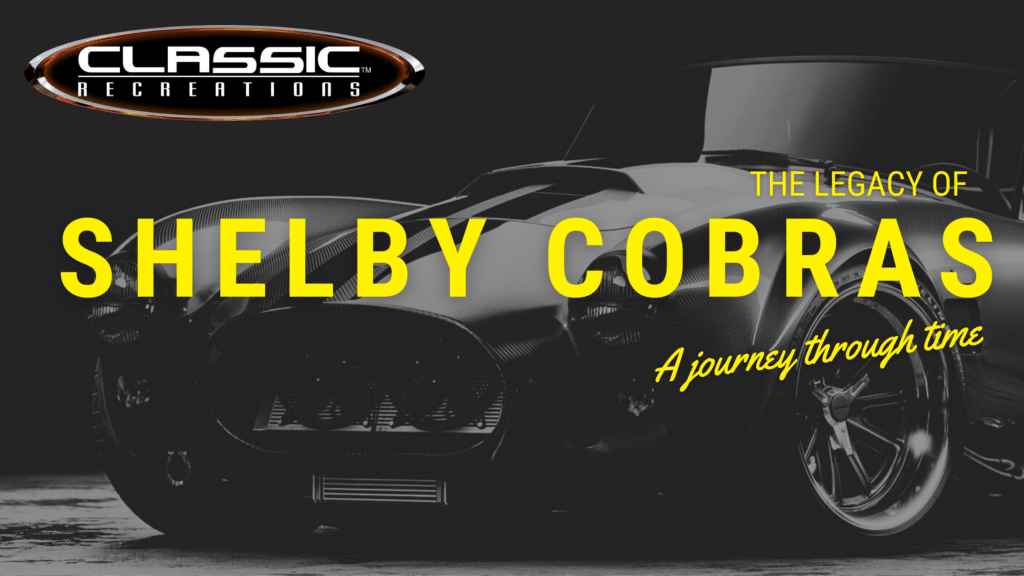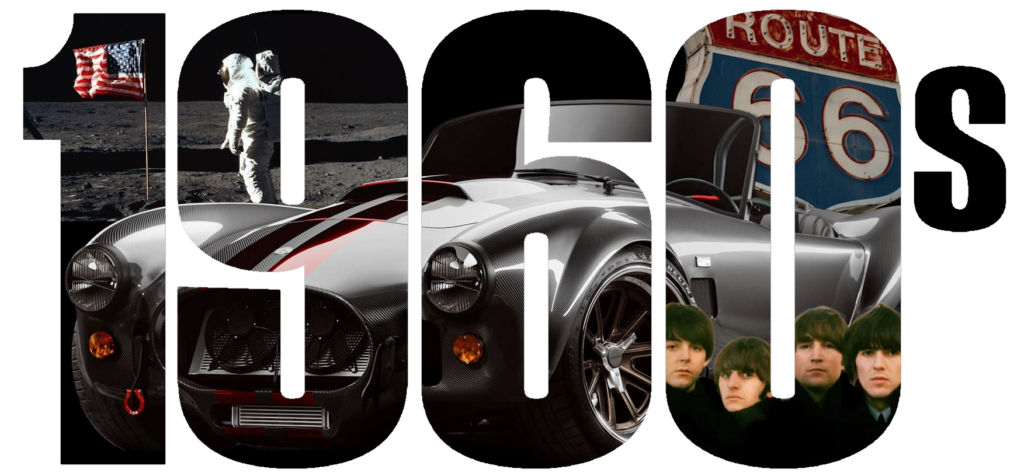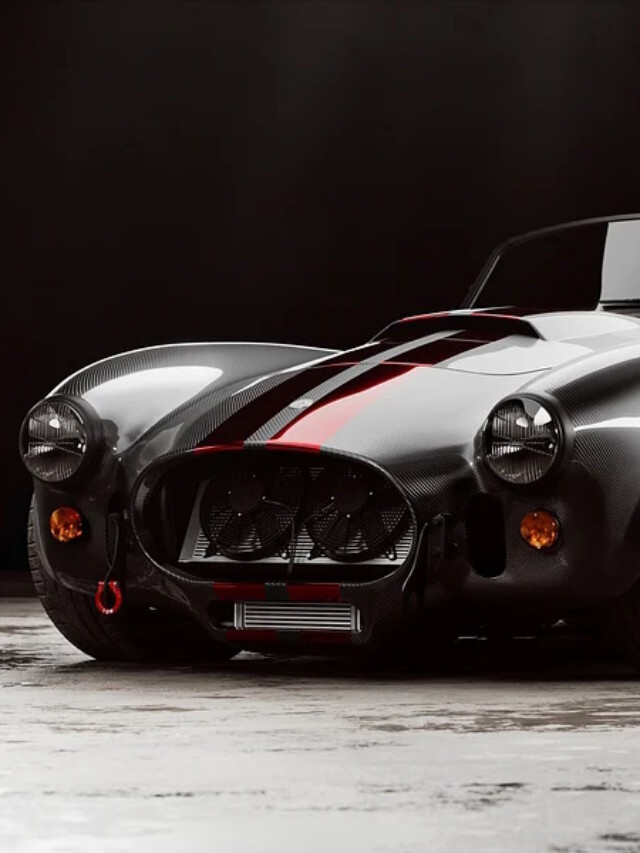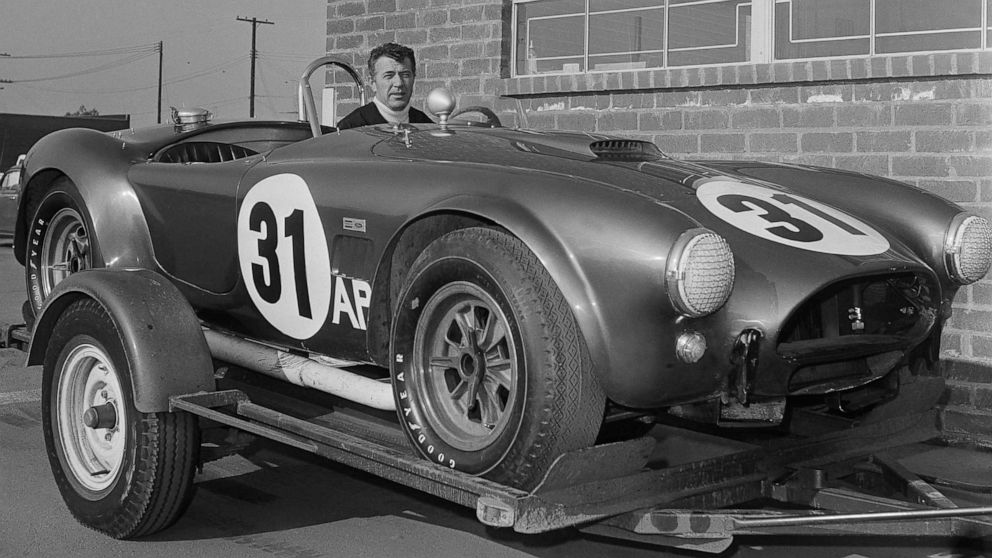The Legacy of Shelby Cobras
Contents

Introduction
In the annals of automotive history, certain vehicles stand apart, transcending their metal, rubber, and paint to become legends. One such legend is the Shelby Cobra, a marvel of engineering and a symbol of an era when passion and innovation coalesced to redefine speed. Yet, to truly appreciate the genius of the Shelby Cobra, one must first transport oneself back to its birthplace—the whirlwind world of the 1960s automotive scene.
Own A Piece Of Automotive History>> Shelby Cobra For Sale
Setting the Stage: The Automotive World in the 1960s
 Picture this: The world was in a state of rapid transformation. The Beatles were revolutionizing music, astronauts were reaching for the stars, and amid this backdrop of innovation and upheaval, the highways and byways echoed with the roar of a new breed of cars. The 1960s wasn’t just a decade; it was an automotive renaissance.
Picture this: The world was in a state of rapid transformation. The Beatles were revolutionizing music, astronauts were reaching for the stars, and amid this backdrop of innovation and upheaval, the highways and byways echoed with the roar of a new breed of cars. The 1960s wasn’t just a decade; it was an automotive renaissance.
Across the pond, Europe’s love affair with motorsport was at its peak. Racing events were more than just competitions; they were grand spectacles attended by royalty, celebrities, and enthusiasts alike. Brands like Ferrari, Jaguar, and Aston Martin were not just manufacturers; they were icons that symbolized luxury, power, and prestige.
Meanwhile, in America, the open road beckoned. As the economy boomed, so did the public’s fascination with speed and style. This was the age of the muscle car, where raw power met the American dream. Cars like the Ford Mustang, Chevrolet Camaro, and Pontiac GTO roared to life, embodying the spirit of freedom and rebellion. Drive-in theaters, diners with roller-skating servers, and the allure of Route 66 painted a vivid picture of an America in love with its cars.
Yet, while Europe focused on finesse and America on raw horsepower, a gap existed. There was a craving for a car that could bridge these worlds—a vehicle that could boast European sophistication and design while harnessing the unbridled power of American engineering.
Enter Carroll Shelby, a retired race car driver with a vision, ambition, and the audacity to dream big. His aspiration? To produce a car that could compete with the best in Europe while capturing the heart and soul of American performance. And as the decade unfolded, this vision would manifest in the form of the Shelby Cobra, a car that wasn’t just built to race but destined to become a legend.
Origins of the Cobra
Every legend has an origin story, and for the Shelby Cobra, it’s a tale that’s as riveting as the roar of its engine.
CARROLL SHELBY: THE MAN BEHIND THE LEGEND
Before we delve into the car, we must first understand the man—Carroll Shelby. A Texan with a penchant for speed, Shelby began his tryst with the automotive world not behind a designer’s desk but behind the wheel. A decorated race car driver, he tasted victory at the grueling 24 Hours of Le Mans in 1959. However, health issues forced Shelby to hang up his racing boots prematurely.
But every end is a new beginning. The end of Shelby’s racing career marked the inception of his dream: creating a car that would bear his name and embody his passion. He envisioned a car that was light, fast, and could compete with Europe’s best on the racing circuit.
Collaboration with AC Cars: Birth of the Cobra
Shelby’s dream might have remained just that—a dream—if not for a fortuitous meeting with AC Cars, a British automaker known for its lightweight and nimble AC Ace roadster. The Ace, with its lithe body and sophisticated design, provided the perfect canvas for Shelby’s vision. However, the car lacked the brute power needed to tussle with the heavyweights of the racing world.
Seeing an opportunity, Shelby approached AC Cars with a proposal: to re-engineer the AC Ace to accommodate a powerful V8 engine. The British automaker, recognizing the potential in Shelby’s vision, agreed, and thus began a collaboration that would rewrite automotive history.
The Fusion of British Design and American Muscle

Shelby’s choice for the engine was Ford’s compact yet powerful V8. As the heart of the AC Ace, this American powerhouse breathed new life into the British frame. It was a match made in automotive heaven: the elegance, agility, and sophistication of European design combined with the raw, unbridled power of American engineering.
This hybrid, christened the ‘Shelby Cobra’, was unlike anything the world had seen. With its gleaming curves, iconic front grille, and the deep rumble of its V8, the Cobra was both a work of art and a force to be reckoned with on the race track.
The birth of the Shelby Cobra wasn’t just an event; it was a defining moment in automotive history. It symbolized the confluence of two worlds, two philosophies, and two legacies. It represented a vision realized and a dream brought to life. And as the 1960s progressed, this dream would roar, race, and rampage its way into legend.
Racing Dominance
The Shelby Cobra’s thunderous arrival onto the automotive scene was not just to sit prettily in showrooms or to grace the pages of glossy magazines. It was bred to race, to dominate, and to etch its mark onto the annals of racing history. And dominate, it did.
Early Racing Achievements: Setting the Tone
From the outset, the Shelby Cobra’s prowess was undeniable. With Carroll Shelby’s racing pedigree fueling its design and purpose, the Cobra soon took American circuits by storm. In 1963, the Cobra made waves by finishing first in its class at the Riverside International Raceway, with Dave MacDonald at the helm. The Corvette, America’s sweetheart, had met its match.
This victory wasn’t an isolated incident. Race after race, track after track, the Cobra showcased its mettle, setting new records and raising the bar for automotive performance. Its combination of lightning-fast acceleration, impeccable handling, and braking capabilities made it a formidable contender in any racing lineup.
The European Challenge: Taking on the Giants
But while its dominance in America was impressive, the true test lay across the Atlantic. Europe was the bastion of motorsport giants—Ferrari, Jaguar, Aston Martin. To be globally recognized, the Cobra had to prove its worth against these stalwarts on their home turf.
And so, the Cobra ventured into the European racing circuits, carrying not just the weight of its own ambition, but the hopes of a nation. The 1964 racing season saw the Shelby Cobra Daytona Coupe, a specially designed variant for high-speed tracks, challenge the might of Ferrari at the 24 Hours of Le Mans. While it didn’t clinch the top spot, its performance was enough to send ripples through the European racing community.
In subsequent races, the Cobra continued to challenge, and often outpace, its European counterparts. Its victories at tracks like Goodwood, Brands Hatch, and Spa-Francorchamps made headlines, firmly establishing the Cobra’s credentials on the global stage.
Signature Races: Landmarks of the Cobra’s Racing Career

While every race added a chapter to the Cobra’s legacy, some events stood out, solidifying its legendary status. The 1965 FIA World Championship was a crowning moment. With the Shelby Cobra Daytona Coupe leading the charge, the team managed to outperform Ferrari, securing the World Sportscar Championship—a first for an American manufacturer.
Another monumental feat was the 1966 Monterey Grand Prix at Laguna Seca. The Shelby Cobra, facing stiff competition and challenging conditions, showcased its versatility, power, and resilience, securing a commendable finish and further cementing its racing legend.
From the buzzing tracks of America to the revered circuits of Europe, the Shelby Cobra wasn’t just a car—it was a statement. A statement that passion, innovation, and sheer will could overcome any challenge. Through its racing dominance, the Cobra didn’t just win trophies; it won hearts, admiration, and an everlasting place in the pantheon of automotive greats.
Design and Engineering Evolution
The journey of the Shelby Cobra is as much about its evolution in design and engineering as it is about its racing legacy. Each iteration of the car carried forward the spirit of innovation, building on previous successes and addressing challenges, making the Cobra not just faster but also a marvel in automotive design and engineering.
The Classic 289: Beginnings of a Beast
The heart of the initial Shelby Cobra was the “289” – a reference to Ford’s 289 cubic inch, or 4.7-liter, V8 engine. Lightweight and powerful, this engine was a perfect match for the nimble and aerodynamic design of the AC Ace body. This fusion gave the Cobra its unique identity: a car that was light on its feet yet packed a punch.
The 289 was more than just an engine; it was a symphony of engineering brilliance. Producing upwards of 270 horsepower, it gave the Cobra the acceleration and top speed to challenge, and often surpass, cars that were considered more powerful on paper.
The Mighty 427: The Evolution of Power
But in the world of racing and automotive excellence, resting on laurels isn’t an option. Carroll Shelby understood this, and by the mid-1960s, he was already conceptualizing the next iteration of the Cobra. Enter the “427”, named after Ford’s 7.0-liter V8 engine.
The 427 wasn’t just a step up from the 289; it was a leap. Producing over 400 horsepower, this beast of an engine required significant changes to the Cobra’s design. The chassis was redesigned for enhanced strength and rigidity. Wider fenders accommodated larger tires for better grip, and the coil spring suspension system replaced the previous leaf springs, ensuring that the car handled its increased power with grace.
This combination of raw power and refined design made the 427 a favorite among racers and enthusiasts alike. It wasn’t just a car; it was a force of nature, commanding respect and awe wherever it went.
The Daytona Coupe: Aerodynamics Meets Muscle
While the roadster design of the Cobra was iconic, there was a growing need for a more aerodynamically efficient design to compete on high-speed European circuits. This need gave birth to the Shelby Cobra Daytona Coupe.
Designed by Pete Brock, the Daytona Coupe retained the muscle and spirit of the Cobra but introduced a sleek, closed-roof design. This wasn’t just for aesthetics; the design was wind-tunnel tested to reduce drag, allowing the Coupe to achieve speeds previously unthinkable for a Cobra.
With its elongated nose, fastback roofline, and a rear end designed for optimal airflow, the Daytona Coupe was an engineering masterpiece. It combined the raw power of the Cobra with the finesse of aerodynamic design, ensuring that it was as much a force on the straightaways as it was in the corners.
From its inception with the 289 to the awe-inspiring 427 and the groundbreaking Daytona Coupe, the Shelby Cobra’s journey is a testament to the relentless pursuit of excellence. It showcases how, with a blend of innovation, passion, and sheer engineering brilliance, a car can evolve from being just a machine to a legend.
Cultural Impact
Beyond the roar of its engine, the curve of its body, and its victories on racetracks, the Shelby Cobra has woven itself into the fabric of culture in ways few cars ever have. Its impact is not just mechanical but deeply cultural, resonating through decades and finding a place in popular imagination.
The Cobra in Popular Culture: Film, Music, and More
The allure of the Shelby Cobra has made it a favorite among filmmakers, musicians, and artists alike. Its distinctive roar, iconic design, and the aura of rebellious luxury it exudes have made it a symbol of speed, power, and freedom in popular culture.
In cinema, the Cobra has been the vehicle of choice for action heroes, renegades, and those living on the edge. Films like “Iron Man,” where Tony Stark drives a Cobra, and classics like “Gumball Rally” have cemented the car’s legacy on the silver screen.
Music too has paid homage to this automotive legend. From rock anthems to bluesy ballads, the Cobra has been eulogized, romanticized, and celebrated. It’s not just a car; it’s an emotion, a symbol of a bygone era, and the eternal spirit of freedom.
Moreover, the Cobra has graced the covers of countless magazines, inspired art installations, and even influenced fashion, with clothing lines and accessories capturing its vintage, rebellious vibe.
Symbolism: What the Shelby Cobra Represents Today
The Shelby Cobra is more than just metal, rubber, and horsepower; it’s an idea, a symbol that transcends its physical form. Today, the Cobra stands as a testament to the vision of one man, Carroll Shelby, and the embodiment of the American Dream—a dream where passion, innovation, and hard work can birth legends.
For many, the Cobra represents the pinnacle of design and performance, a time when cars were not just about getting from point A to point B, but about the journey itself. It’s about the open road, the wind in your hair, and the thrill of raw power at your fingertips.
Moreover, in an era defined by mass production and automation, the Shelby Cobra reminds us of a time when cars were handcrafted, each piece fitted with care, each vehicle a unique masterpiece. It stands for craftsmanship, attention to detail, and the artistry that goes into creating something truly exceptional.
Beyond its undeniable aesthetic and performance credentials, the Cobra has come to symbolize resilience, audacity, and the spirit of challenge. It’s a beacon for dreamers and disruptors, a reminder that with passion and perseverance, one can defy the odds and leave an indelible mark on the world.
Through the annals of time, while many cars have come and gone, few have captured the imagination and heart of people like the Shelby Cobra. Its legacy isn’t just in its design, speed, or engineering, but in the stories it has inspired, the dreams it has fueled, and the cultural tapestry it continues to enrich.
Legacy and Preservation
In the vast galaxy of automobiles, the Shelby Cobra twinkles as one of the brightest stars. Its legacy is enduring, transcending its original purpose as a racing machine to become an icon of heritage, luxury, and prestige. Today, as vintage car enthusiasts and collectors venerate the Cobra, there’s a resounding emphasis on preserving its history and maintaining its glory.
Collector’s Pride: The Modern-Day Significance of Owning a Cobra
To own a Shelby Cobra today is to possess a slice of automotive history. It’s not just about the vehicle’s value, which undoubtedly is immense given its rarity and significance, but about being a custodian of a legacy.
For collectors, the Cobra isn’t just a car—it’s a story. A story of ambition, innovation, and the relentless pursuit of speed. Each Cobra, with its unique quirks, patina, and history, has a narrative to tell, making them invaluable additions to any collection.
Owning a Cobra is also a statement. It speaks of discernment, appreciation for craftsmanship, and a deep-rooted love for automotive heritage. In a world dominated by electric vehicles and self-driving cars, the Cobra stands as a testament to raw, unadulterated power and the joy of driving. It’s a nod to a simpler time, an era of carburetors, manual transmissions, and the visceral thrill of a V8’s roar.
Preserving the Legend: Restoration and Maintenance
While owning a Shelby Cobra is a matter of pride, preserving it is a labor of love. Many Cobras have lived hard lives—racing, touring, and being driven as they were meant to be. As a result, they bear the scars of time, wear, and adrenaline-fueled adventures.
Restoration is a delicate dance between preserving authenticity and ensuring the car remains in its prime. It’s not just about fixing dents and repainting; it’s about understanding the vehicle’s history, respecting its original design, and using period-correct materials and techniques.
Many Cobra enthusiasts and restoration experts go to great lengths to source original parts, study archival photographs, and even consult with those who originally worked on these cars to ensure that every restoration detail is accurate. The goal is to breathe life back into the car without erasing its storied past.
Maintenance, too, is crucial. Given the Cobra’s age and the rarity of its components, regular care is vital. This includes not just mechanical maintenance but also preserving the car’s interior, exterior, and even its documentation and provenance.
The Shelby Cobra’s legacy is enduring, its story interwoven into the very fabric of automotive lore. For those fortunate enough to own, restore, or even just admire one, the Cobra isn’t just a car—it’s a monument to ambition, artistry, and the age-old human desire to push boundaries. In preserving and cherishing these vehicles, we ensure that the legend of the Shelby Cobra roars on, echoing its tales of glory for generations to come.
Influence on Modern Automotive Design
Every now and then, a creation emerges that sets the precedent, influencing and inspiring generations that follow. In the realm of automotive design, the Shelby Cobra stands tall as one of those trailblazers. Its boldness, innovation, and sheer audacity have left imprints on the DNA of many modern supercars and automotive designs.
Modern Supercars: Tracing Back to the Cobra’s Design Principles
When you closely examine many of today’s supercars, it’s evident that the Cobra’s influence is more than just superficial. There are underlying design principles and philosophies that harken back to Shelby’s masterpiece.
- Performance through Weight Savings: One of the core tenets of the Cobra was the idea that performance wasn’t just about power; it was about weight. The Cobra’s lightweight design, combined with a powerful engine, gave it an enviable power-to-weight ratio. Modern supercars, with their extensive use of carbon fiber, titanium, and other lightweight materials, embody this principle.
- Simplicity and Functionality: The Cobra’s design was purpose-driven. There weren’t any unnecessary frills; everything was geared towards performance. Today, supercars, beneath their sleek and sometimes complex exteriors, prioritize functionality, aerodynamics, and performance, much like the Cobra did in its time.
- Blending of Cultures: The Cobra was a harmonious blend of British design aesthetics and American muscle. This international collaboration approach is seen today in supercars that combine design and engineering influences from different parts of the world, creating vehicles that appeal to a global audience.
Shelby’s Ongoing Legacy: Modern Iterations and Continuations
The Cobra’s legacy hasn’t been confined to the annals of history. It continues to inspire and evolve in the modern age.
- Modern Shelby Cars: Today’s Shelby American company, building on Carroll Shelby’s legacy, continues to produce high-performance variants of Ford vehicles. While these cars are technologically advanced and cater to contemporary demands, the spirit of raw power, audacious design, and racing pedigree remains intact.
- Continuation Models: Recognizing the undying passion for the classic Cobras, several authorized “continuation” models have been produced. These cars, while built in recent years, closely adhere to the original specifications and design of the 1960s Cobras. They serve as a bridge between the past and the present, allowing enthusiasts to experience the magic of the original Cobra with the benefits of modern craftsmanship.
- Inspirations in Other Brands: Beyond direct iterations, the ethos of the Cobra lives on in various modern vehicles across different brands. Whether it’s in the aggressive stance, the pursuit of pure driving pleasure, or the blend of design and performance, the spirit of the Cobra is palpable in many of today’s high-performance cars.
The Shelby Cobra wasn’t just a car; it was a revolution. Its influence permeates the automotive world, shaping designs, philosophies, and the very essence of what a performance car should be. As the automotive landscape evolves, with electric powertrains and autonomous vehicles making their mark, the Cobra’s legacy serves as a poignant reminder of the raw, unfiltered passion that cars can evoke. And in that spirit, its influence is eternal.
Conclusion
The Undying Allure of the Shelby Cobra
As the sun sets on our journey through the world of the Shelby Cobra, one truth stands unwavering: the allure of this iconic machine is timeless. Beyond its sleek curves, its rumbling roar, and its legendary speed, the Cobra embodies a dream, a passion, and an era where audacity and vision fused to create automotive magic.
In its day, the Shelby Cobra was a disruptor, a beacon of innovation that challenged the status quo and redefined the boundaries of performance. Today, it remains a symbol of that daring spirit, a testament to the age-old adage that with passion, vision, and a touch of genius, anything is possible.
Its tales of racing triumphs, the genius of Carroll Shelby, and its influence on modern automotive design make it more than just a car. The Shelby Cobra is an experience, an emotion, and an inspiration. Its stories have been told across generations, through the purr of its engine, the gleam of its chrome, and the tales of those fortunate enough to have driven or even simply beheld it.
In a rapidly changing world, where technology often eclipses tradition and digital often drowns out the analog, the Cobra stands tall as a reminder of the beauty of simplicity, the thrill of raw power, and the joy of unbridled freedom.
It’s not just about metal, rubber, or horsepower. It’s about the human spirit, the drive to innovate, and the desire to leave an indelible mark. The Shelby Cobra, in its majestic glory, encapsulates all of this and more.
And so, as years turn into decades and decades into centuries, the legend of the Shelby Cobra will endure. It will continue to inspire, captivate, and enthrall, its legacy forever undiminished, its allure forever undying.


